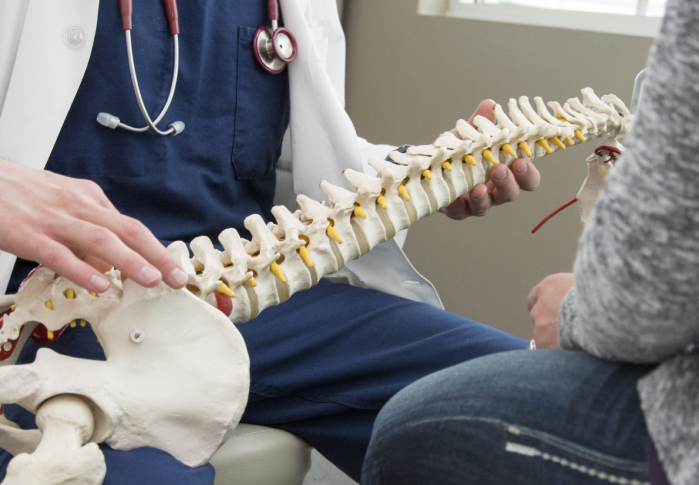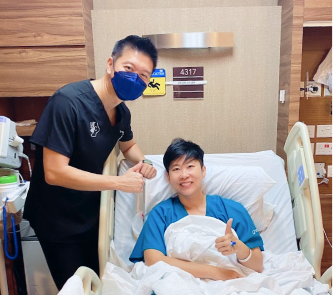Spine Surgery
While some spine conditions can be treated non-surgically through conservative methods, spine surgery may be necessary to treat more serious spinal injuries and conditions, such as:
- Herniated Disc: Also known as a slipped disc, a herniated disc is an injury of the spine or the backbone. This occurs when the nucleus (gel-like material inside the spinal discs) breaks through the annulus (rubbery exterior covering the nucleus) and presses on spinal nerves, which causes pain and inflammation.
- Sciatica: This refers to pain that arises from a herniated disc putting pressure on the sciatic nerve – the longest nerve in the body running from the lower back through the buttocks and down the legs. Typically, this affects one side of the body and causes numbness and tingling sensation, as well as the sensation of pain shooting down the leg.
- Spinal Stenosis: Spinal stenosis occurs when one or more nerve passageways and the spinal nerves narrow, putting pressure on the spinal cord and the spinal nerve roots. This is commonly caused by arthritis or joint degeneration. Symptoms include back pain, burning pain and numbness in the buttocks or legs, as well as weakness in the legs.
- Degenerative Disc Disease: This occurs when the spinal discs – rubbery cushions between the bones in the spinal column (vertebrae) – wear down, causing pain in the neck or lower back and sometimes extending into the arms and hands or into the buttocks and legs. The spinal discs naturally degenerate with age, however injuries, obesity and performing physically demanding activities can increase the risk of developing degenerative disc disease.
- Spondylolisthesis: This condition occurs when the vertebra slips out of place onto the vertebra below it. Spondylolisthesis may be congenital, degenerative, or caused by injuries, diseases, or tumours. It may cause stiffness in the back, muscle spasms in the hamstring, difficulty walking or standing for long periods, and numbness or tingling in the foot.
- Vertebral Compression Fracture: This condition occurs when the vertebral body in the spine collapses, typically due to trauma and/or osteoporosis. Vertebral compression fractures can cause sudden severe back pain, deformity, and even loss of height.
- Spinal Tumours: A spinal tumour can be located within or surrounding the spinal cord and/or the spinal column. This tumour can be benign or malignant. These tumours can cause pain, loss of sensation, muscle weakness, loss of bowel or bladder function, or even paralysis.

- Spinal Fusion – This involves connecting two or more adjacent vertebrae through a small bone graft from other parts of the body or from a donor to help the bones grow and fuse. Spinal fusion may help alleviate the symptoms of several back problems, such as degenerative disc disease, herniated disc, spondylolisthesis, and spinal stenosis.
- Artificial Disc Replacement – This is usually recommended for patients with arthritis or osteoporosis. During the surgery, the damaged disc is replaced with an artificial disc to relieve back pain while maintaining a greater degree of mobility.
- Discectomy – This is used to treat a slipped (herniated) disc and is performed by partially or fully removing the affected disc. This helps to alleviate the symptoms caused by a herniated disc pressing on a nerve root or spinal cord.
- Spinal Decompression – Also called spinal laminectomy, this is performed to treat spinal stenosis. During the procedure, the spine surgeon creates a space in the spinal column by removing bone spurs and tissues to reduce pressure on the nerves.
- Transforaminal Lumbar Interbody Fusion – This is a form of spinal fusion surgery where a spine surgeon accesses the lumbar spine through the intervertebral foramen, removing disc material and fusing vertebrae to stabilize the spine and alleviate nerve compression. It is used to treat conditions like degenerative disc disease and herniated discs.
As with all other surgical procedures, there are possible risks following a spine surgery, which include:
- Infection: Postoperative infection is characterized by the presence of bacteria on the surgical site, which may lead to pain, swelling, and fever.
- Bleeding: While some light bleeding is normal after surgery, excessive bleeding – especially accompanied by other symptoms – is not.
- Blood Clots: Formation of blood clots is a potential risk after spine surgery. Vigilant monitoring and preventive measures can reduce the likelihood of clot formation.
- Post-operative Pain: While some post-operative pain is expected, persistent or intense pain is not normal and need to be quickly addressed.

After Spine Surgery?
After a spine surgery procedure, the patient will be transferred to a recovery room for close monitoring and will also be given pain medications and rehabilitative treatment to support their recovery.
Most patients start physiotherapy within 24 hours post-surgery. This involves customised sets of exercises to improve their strength, stability, flexibility, and control. Patients continue physiotherapy even after being discharged from the hospital until they are fully recovered.
Aside from physiotherapy, the patient will also be given instructions on proper wound care and pain management to aid the patient’s comfort while recovering.
FRCSEd (Orth), FAMS
Fellowship-trained Singapore spine surgeon Dr Kevin Koo has over 20 years of expertise in the field of orthopaedic surgery. During his fellowship at Imperial College Healthcare in London, UK, he honed his skills in advanced surgical techniques for spinal conditions under the guidance of internationally renowned surgeons.
Beyond his clinical practice, Dr Koo is dedicated to advancing the field. He serves as an Adjunct Assistant Professor at both NUS Yong Loo Lin School of Medicine and Duke-NUS Medical School, where he actively contributes to the education and training of future generations of surgeons.



| Tel. | : +65 6970 5905 |
| Fax | : +65 6970 5906 |
| Mobile | : +65 9898 7781 |
| : hello@bjc.sg, drkevinkoo@bjc.sg |
| Mon - FriMonday -Friday | : 8:30am to 5:30pm |
| Sat, Sun and PHSaturday, Sunday & PH | : Closed |
Well-being: Our Focus at
The Bone & Joint Centre.
We know that getting back to the activities you love is what truly matters. We are committed to providing high-quality, compassionate care to help you regain the ability to live life to the fullest.
Call us at 9898 7781 or fill out the form below and we will
get in touch as soon as possible.
| Tel. | : +65 6970 5905 |
| Fax | : +65 6970 5906 |
| Mobile | : +65 9898 7781 |
| : hello@bjc.sg, drkevinkoo@bjc.sg |
| Mon - FriMonday -Friday | : 8:30am to 5:30pm |
| Sat, Sun and PHSaturday, Sunday & PH | : Closed |





